449 Search Results for VISUAL SUPPORTS
June 29, 2013
by Carole Zangari -
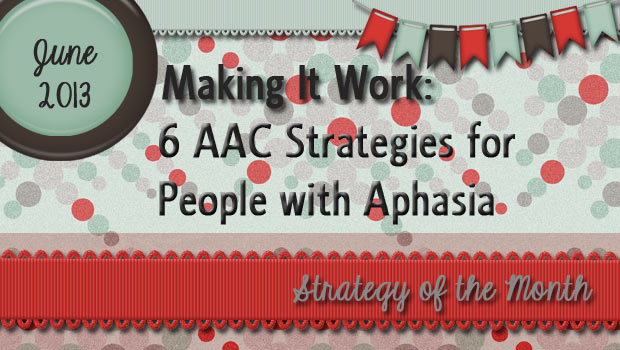
People with aphasia are often most successful when a number of different strategies are combined. In this post, we discuss a number of strategies that we can use in our therapy and teach to communication partners. Augmented Input We’ve written so many posts about aided language input that we’re almost embarrassed to bring it up again. Almost. It seems like no matter which age group or clinical population is the subject of our post, that strategy plays a central role. It is the same for people with aphasia with one exception. They benefit from a broader array of input cues, such as gestures, writing, and even pantomime. Augmented input is the term that is used to refer to oral language that is supplemented with pictures, print, gestures, pantomime, and the use of objects in the environment. By using these things as you speak, you enhance the ability of the person... [Read More...]
June 1, 2013
by Carole Zangari -
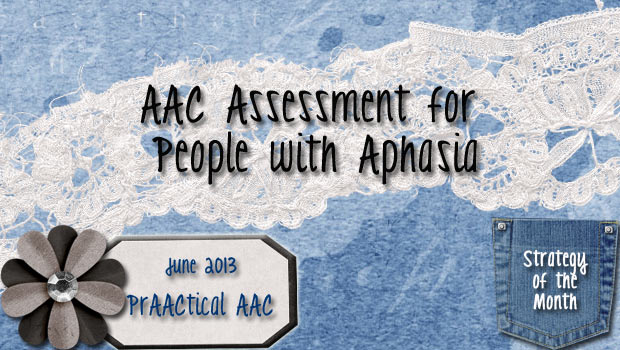
Many people with aphasia fail to regain sufficient speech and language skills to meet their communication needs. With more than one million people with aphasia in the US alone, chances are most people reading this know at least one person affected by the disorder. While many go on to regain functional speech and language skills, some remain unable to communicate well enough catch up with a neighbor, talk about bills with a spouse, ask a question in a store, play with a grandchild, or tell their healthcare providers about side effects or symptoms. It’s hard to really imagine how devastating and isolating this experience may be. Aphasia Awareness Month seemed like the perfect time to reach out to SLPs with information on AAC for people with aphasia. In this post, we’ll share some thoughts and resources on assessment. Assessment activities are, of course, driven by the purpose for which the... [Read More...]
May 9, 2013
by Carole Zangari -
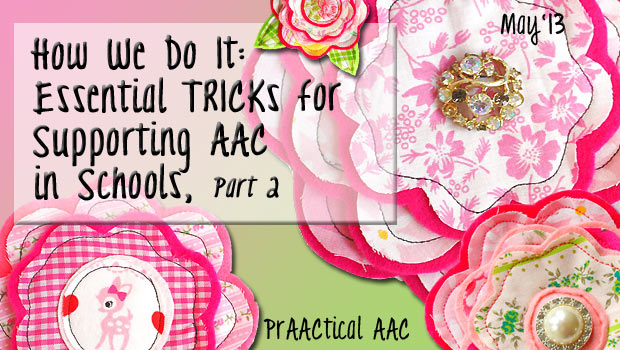
Today we welcome back 3 SLPs from the Orange County Public School (OCPS) AT team, Cathy George, Marcia Sterner, and Marcia Piersall. They are part of a very active and competent AT Team that supports over 700 students with dedicated AAC devices. It is no surprise that they’ve come up with a list of 5 essential TRICKs that they count on to help them support these students and their educational teams. You can read about the first 2 TRICKS, Try It and Resources, here and download some of their terrific resources. Today, we learn about the rest of their TRICKs: Information, Can’t Live Without It, and Kick It Up A Notch. Give Me Five: Essential TRICKS, Part 2 INFORMATION about the student Student interests What systems previously tried What tasks s/he is struggling with Trial data sheet– Communicative competence organizer CAN’T LIVE WITHOUT IT: In addition to AAC devices, these... [Read More...]
April 13, 2013
by Robin Parker -

The focus this month is on core word vocabulary and effective teaching strategies. Most core vocabulary is represented through abstract symbols that range from translucent (i.e., makes sense after it is explained) to opaque (i.e., doesn’t have any resemblance to the word or concept) which makes the need for effective teaching all the more important. It also makes it more fun because meaningful language experiences, emotional language experiences, and repetition with variety experiences are going to be the platform for teaching. Within the platform of authentic language experiences, layers of teaching strategies can be applied. The more strategies we apply to learning, the more we assure ALL learners will benefit from our teaching. Core word vocabulary teaching begins with a few premises that underlie the process. These are not new ideas but ones that should be reaffirmed as you begin teaching. It is important, as always, to presume competence. All learners... [Read More...]
April 9, 2013
by Robin Parker -

Strategy of The Month Narrative Skills for People with AAC Needs PrAACtical AAC & Personal Narratives Narrative Assessment & People Who Use AAC Let Me Tell You Something: Narratives for the Beginning Communicator Helping People with AAC Needs Develop Personal Narratives PrAACtical Thinking PrAACtical Guessing: 5 APPs for Interactive Inferencing Another Look at Vocabulary Instruction in AAC Magic Moments in Building Vocabulary with ‘Its Cool to be Clever’ It’s PrAACtically Saint Patrick’s Day 28 Posts You May Have Missed in February 10 AAC Things To Do for PrAACtically Free in 10 Minutes of Less Daylight Savings Time & PrAACtical Behavior Another Look At Language Facilitation Strategies to Make AAC Learning Effective Literacy, AT, & Students with Significant Disabilities Watch This: Planning with Strategies Worth Repeating: Big Ideas in Teaching AAC Vocabulary PrAACtical Passover & Easter Supports 30 Things to do During Autism Awareness Month A Beautiful Family, But 1 Question... [Read More...]
March 28, 2013
by Carole Zangari -
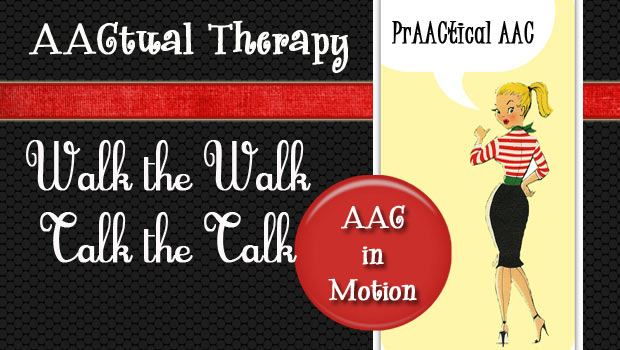
Tanna Neufeld hits another homerun with this post about co-treating children with multiple disabilities. Collaborating with our colleagues is both fun and challenging. Let’s take a look at the prAACtical ways that Tanna and her colleagues support kids with motor and visual impairments who are learning to use AAC. Fridays are my favorite. And not just for the obvious reasons (TGIF), but also because Fridays are one of the most challenging and exciting days of my work week. Every Friday, I am lucky enough to team with my favorite PTs for joint treatment sessions to support several children with multiple motor and communication challenges. Around our center, we lovingly refer to these kids as our “motor kids”. All of these little ones are nonverbal, and all have very complex motor challenges that significantly limit their ability to interact with traditional play and learning environments. Many of these kids also... [Read More...]
March 21, 2013
by Carole Zangari -
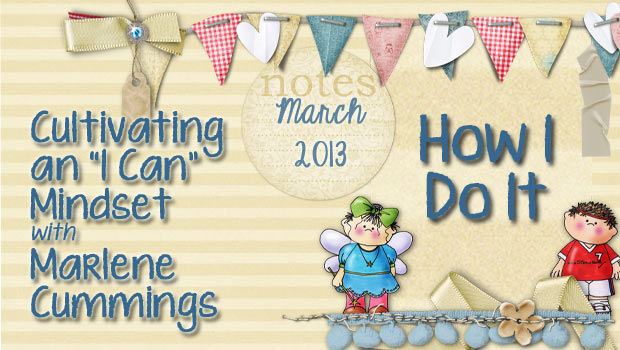
As much as we love fresh new voices in the AAC community, there is simply nothing like the voice of experience. When a program has had more than 40 years of experience providing AAC services, we listen! Today, we are honored to have Marlene Cummings, an AAC SLP from Michigan, share the collective wisdom of her team. I have found that one of the joys in my professional life is asking hard questions about my present work and then figuring out ways to address those questions. Much of my 30 + years have been spent designing and implementing programs, systems and materials to support young children with complex communication needs in the role of the teacher in these classrooms. I explored ways to design environments and develop curricular frameworks and instructional materials, which would provide students with the instruction and opportunities to become competent communicators, all from the view of... [Read More...]
February 13, 2013
by Carole Zangari -
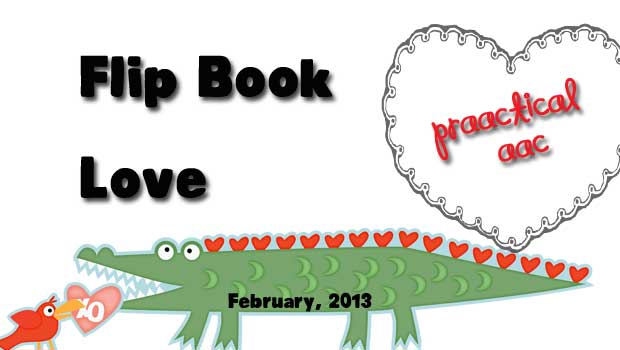
We love the versatility of flip books and charts. They are a great format option for communication books, particularly the flip books that have a static ‘base’ and a set of strips/mini pages that you can flip through for additional vocabulary. Once you have a template, it’s not too difficult to make a number of them that fit different purposes. Here are some resources to explore. SET-BC has wonderful material on communication supports including a brief video about flip books here. They also have some terrific downloads, including this one by Kathy Ryan. Flip ‘n Talk has been around for a long time, but it continues to be a really useful tool. We typically have the core language as the static portion, but here’s an example of doing it the other way around. There are so many ways to use flip books for language learning. We love this one for... [Read More...]
February 5, 2013
by Robin Parker -
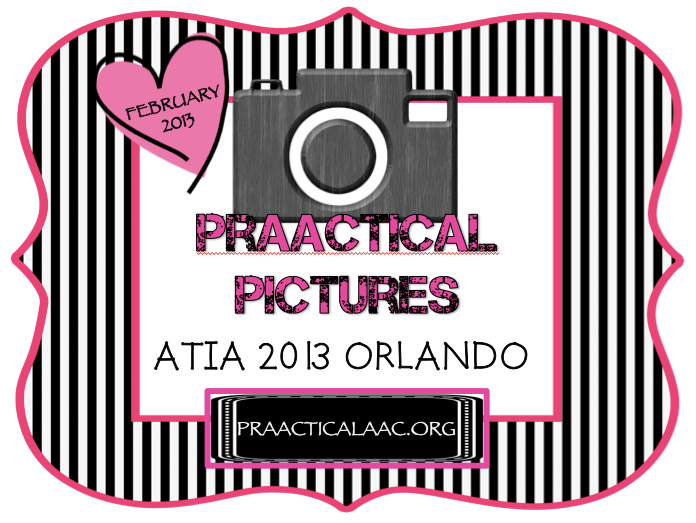
All we can say is Wow! ATIA 2013 Orlando was awesome! Since it is February, we will focus on things we LOVE as it relates to our ATIA experience. Here are just a few thoughts and pictures from our time in the Exhibit Hall. (Please note, this is just a small sample of the many, many things seen and learned. Our list is based on the pictures we took and the time we had in the Exhibit Hall (both limited). A comprehensive list of Exhibitors can be found at the ATIA 2013 Orlando Site under the Exhibit List. So much to see and learn! FRS Custom Solutions.- We loved meeting the FRS Team (especially since they are based in Fort Lauderdale) and learning about the CommLink ProSlate Series. Fat Cat Chat– Love the Fat Cat Chat apps for ‘small talk’ (Thanks Jane Farrall for blogging about Fat Cat Chat apps). Immediately... [Read More...]
February 2, 2013
by Carole Zangari -

Although it has been close to 25 years since Dr. Janice Light’s hallmark paper on communicative competence in AAC discussed four main purposes of communication, many AAC systems are still heavily populated with messages for basic wants and needs. The other areas – information transfer, social closeness, social etiquette – are often underrepresented in AAC systems. We scratched the surface of how to teach basic requesting last month, and now we’re ready to talk about communicating for other reasons. In this post, we’ll talk about some of the clinical issues in teaching communication for the purpose of information transfer. A big reason that we express ourselves is to share information that others want or need. It may not seem like a high priority until we realize how often we need to do this to function in our daily lives. Here are some examples, both positive and negative, from our work... [Read More...]









